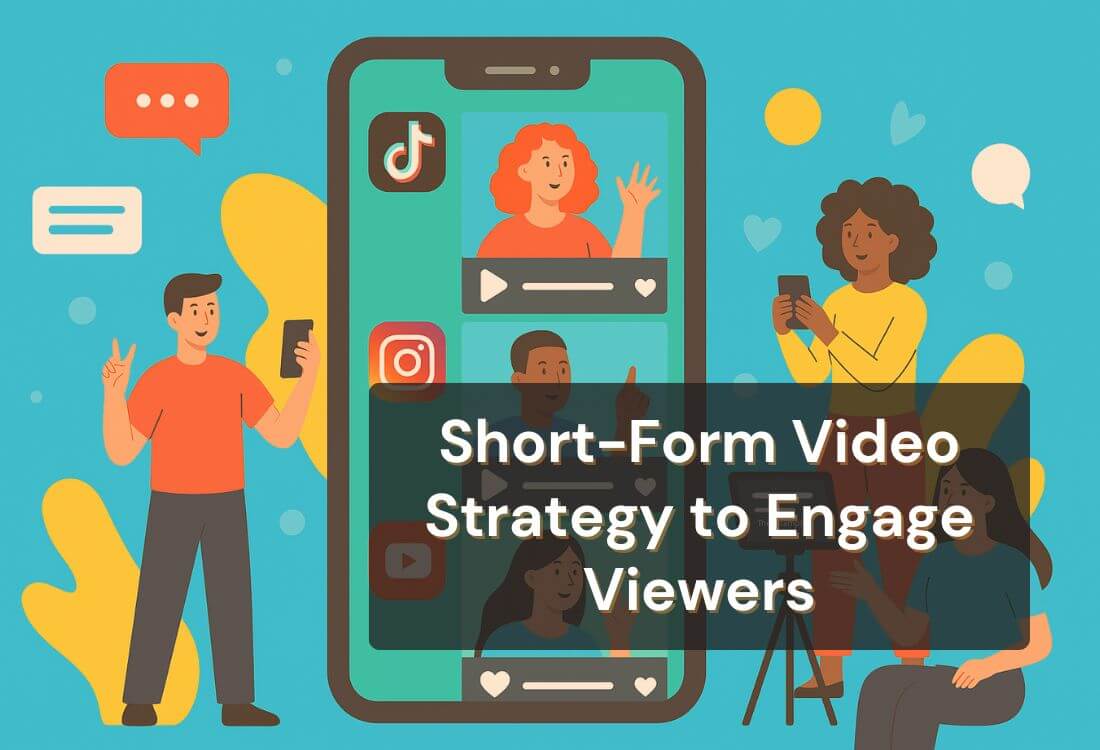



TL;DR: Short-form videos, usually under 60 seconds, are the star format on TikTok, Instagram Reels, and YouTube Shorts. They work because they grab attention quickly, spark engagement, and are easy to create. With clear goals, a good understanding of your audience, and consistent creativity, you can turn short videos into a powerful growth tool.
Short-form video content has reshaped how people consume information and entertainment. Scroll through TikTok, Instagram Reels, or YouTube Shorts, and it’s clear these bite-sized clips are leading the way in digital storytelling. They’re quick, punchy, and incredibly effective: nearly three-quarters of consumers say they prefer short videos when researching products or services.
For creators, businesses, and brands, short-form video isn’t just a trend—it’s an essential strategy for building awareness, sparking engagement, and driving results. This guide explores why short-form video is so popular, the benefits it brings, and how to craft a winning strategy that makes every second count.

Short-form videos (generally under 60 seconds) have exploded in popularity for several compelling reasons:
In summary, short-form video hits the sweet spot for modern audiences: it’s quick, engaging, and everywhere. But success isn’t guaranteed by format alone, you need a smart strategy to make every second count.
Building a short-form video strategy means planning how you’ll use these quick videos to achieve your goals. It’s not about churning out random 30-second clips – it’s about creating the right content, for the right people, in the right way. Here are key steps and tips to develop your strategy:

Start by deciding what you want to achieve with short-form videos. Is it to increase brand awareness, drive social media engagement, educate your audience, or promote a product launch? Clear goals will guide your content.
For example, if your goal is brand awareness, you might focus on entertaining, shareable videos. For education or thought leadership, you might create quick how-to clips or tips. Knowing your objective helps determine your video topics, style, and the metrics you’ll track (views, likes, click-throughs, etc.).
A successful strategy is audience-centric. Research who your target viewers are and what they like. Which platforms do they spend time on? What topics or trends grab their attention? Understanding your audience’s preferences will inform your content ideas.
For instance, if you target Gen Z, hopping on fun TikTok challenges or using trending music might be effective. If you’re targeting professionals on LinkedIn, a more informative and polished short video might work better. Tailor your tone and topics to what resonates with your viewers.
Not all short-form videos belong on every platform – pick the channels that align with your audience and goals. TikTok, Instagram Reels, YouTube Shorts, Snapchat Spotlight, LinkedIn, Facebook – each has a slightly different vibe and user base. Focus on the platforms where your audience hangs out the most.
For example, TikTok skews younger and trend-driven, Instagram Reels tap into Instagram’s broad user base (with strengths in lifestyle, fashion, travel niches), and YouTube Shorts might reach a more general audience or complement your YouTube long-form content.
Optimize your videos for each platform’s specs and culture (e.g. vertical 9:16 format is standard; TikTok might favor use of text overlays, popular sounds, and hashtags, whereas LinkedIn videos might avoid meme-style edits). By meeting your audience where they are, you’ll see better engagement.

With goals and platform in mind, plan out the content themes and topics you will cover in your short videos. Think about the stories or messages you can tell in under a minute. What value will each video provide – will it inspire, educate, entertain, or convince viewers?
Outline your ideas and write a brief script or storyboard for each video so you know how it will flow. Planning is crucial because in a 30-second video, every second counts. Aim to keep most videos in the 15–60 second range for maximum impact – many marketing experts find the sweet spot for short videos is around 30–60 seconds long.
If you struggle to condense your message, focus on a single key point or tip per video rather than cramming too much in. A well-crafted script helps ensure you hit the important points quickly.
(Pro tip: To deliver your message smoothly without ad-libbing or forgetting lines, consider using a teleprompter tool when recording. Teleprompter.com allows you to read your script on-screen while looking into the camera, so you can stay concise and confident.)
In short-form content, the first 2–3 seconds are critical. As users swipe through an endless feed, you need to grab their attention immediately or they’ll scroll past. Start your videos with something eye-catching or curiosity-piquing. This could be a bold visual (bright colors, big text, or an interesting scene) or an intriguing statement/question spoken right at the beginning.
For example, begin with a startling fact, a quick preview of the end result, or a visually striking moment. Avoid slow intros or logos at the very start, you can always include branding later in the video, but first you must earn the viewer’s attention.
Short videos should be visually dynamic to keep people watching. Film in vertical format (9:16) so the video fills the entire phone screen – this is the native format for TikTok, Reels, and most short video placements.
Use good lighting and clear image quality so your video looks professional even if made with a phone. Incorporate quick cuts, close-ups, or on-screen graphics and emojis where appropriate to add flair.
Text overlays are also powerful in short videos: you can use text to highlight key points or steps as you speak, reinforcing the message. Visual creativity goes a long way in making your 15-second clip stand out in a crowded feed.
Don’t rely on sound alone to get your message across. A large portion of people watch videos with the sound off, especially when on mobile or in public. In fact, about 85% of Facebook videos are watched on mute, and many viewers simply prefer having captions.
Always add captions or subtitles (even just auto-captions or brief text summaries of what’s being said) so that someone scrolling silently can still follow along. Captions also make your content accessible to wider audiences. Of course, audio isn’t irrelevant – music and sound effects can greatly enhance a short video’s appeal.
Choose background music or popular songs that match the mood (many platforms have libraries of trending sounds you can use). If you’re speaking on camera, invest in clear audio recording.
Optimal strategy: Make sure your video is effective with or without sound. That means a viewer should get the gist even if muted (thanks to captions/visuals), but those who do listen will enjoy music, narration or dialogue that pulls them in further.
One reason short-form content took off is the authentic, human feel it often has. People connect with relatable, down-to-earth videos more than overly polished commercials. Don’t be afraid to show some personality, humor, or behind-the-scenes realness in your short videos. Let your unique style shine.
Speak in a conversational tone as if talking to a friend. If you fumble a word or something isn’t perfectly slick, that’s okay – it can even make you more relatable. Highlight your brand’s culture, values, or the people behind the product. Authentic storytelling builds trust and makes viewers more likely to engage and remember you. Short videos are a great place to be creative and have fun while still delivering value.
One of the fastest ways to boost visibility on platforms like TikTok or Reels is to participate in trending challenges, hashtags, or audio memes. Keeping an eye on what’s trending can spark ideas for your own content.
For example, if there’s a popular dance or meme format, think about how you might put your own twist on it relevant to your niche. Jumping on a trend at the right time can expose your content to a huge audience as people search that trend. However, always keep it on-brand. Don’t do a trend that clashes with your brand image or values just for the views.
To effectively use trends, integrate them with your brand's message. For instance, a fitness brand could adapt a trending dance to include workout moves, while a B2B company might use trending audio to convey a quick business tip. Trends should enhance your message, not overshadow it.
Consistency is key in any social strategy. Develop a posting schedule you can maintain – whether that’s 3 TikToks a week or 1 Reel every weekday. Regularly putting out content trains both the algorithm and your audience to expect new videos from you, which can improve reach over time.
Monitor when your target viewers are most active on each platform (many social apps provide audience analytics showing peak times) and try to post during those windows to maximize initial engagement. That said, quality outweighs quantity; it’s better to post fewer high-value videos than daily low-effort clips. Find a cadence where you can stay consistent without sacrificing quality.
Once you start rolling out short videos, closely track how they perform. Almost every platform offers analytics – view counts, likes, shares, completion rate, and sometimes more details like drop-off time or engagement rate.
Pay attention to which videos perform the best and look for patterns. Do viewers love your behind-the-scenes clips more than your product demos? Did that 15-second video retain viewers better than the 60-second one? Use these insights to continually refine your strategy.
Don’t be afraid to experiment with new ideas, but let data guide you. If something flops, analyze why – maybe the hook wasn’t strong enough, or perhaps it was posted at a bad time. If something succeeds, consider creating more content of that style or expanding on that topic.
Agility is the name of the game; the short-form video landscape and trends can change quickly, so a great strategy is one that evolves with the audience.
If your videos aren't performing as well as you'd hoped, it's a good idea to review your current process and pinpoint any areas for improvement. For more detailed information, refer to the guide on Top Issues with Short-Form Video Content.

One challenge with short videos is constantly coming up with new content ideas that fit the format. Here are some proven short-form video ideas and formats you can incorporate into your strategy:
Show viewers what happens behind the scenes in your work or creative process. This could be a quick tour, a morning routine, or a snippet of your team in action. It makes your brand more relatable and gives audiences an insider feel.
Share quick, actionable tips or tutorials that fit into 30–60 seconds. Focus on a single step or hack to keep it concise. Educational clips are highly shareable and position you as an expert.
Build excitement with short teaser videos for upcoming launches or events. Show intriguing glimpses without revealing everything. End with a clear call-to-action to follow or learn more.
Feature authentic clips from happy customers or your community. Short testimonials and reactions build trust quickly. Encourage fans to share their own videos to create a loop of engagement.
Participate in trends that fit your brand’s voice and audience. Add your unique twist to stand out from countless similar videos. Trends can give you a fast boost in reach when done well.
Answer common questions or correct misconceptions in your field. Keep responses short and engaging so viewers stay to the end. This format sparks curiosity and invites more interaction.
For more inspiration, check out our full list of video content ideas.
Before we wrap up, let’s summarize a few best practices that apply to almost all short-form videos:
Don’t be tempted to push the time limit. The beauty of short-form is its brevity. If you can convey your message in 20 seconds instead of 60, do it. Respect your viewer’s time and they’ll be more likely to watch to the end (and come back for more).
Many viewers and marketers agree that roughly 30–60 seconds is an optimal length for most short videos. Some platforms even favor ultra-short 15-second videos. Experiment, but err on the side of shorter and punchier.
Even in a short video, you should give viewers a next step. It could be as simple as “Like and follow for more tips!” at the end, or “Check the link in bio for the full tutorial/blog/product”. If you just entertained or informed someone in 30 seconds, they might be very willing to engage further, but you often need to prompt them.
A quick CTA in text or spoken form can convert a passive viewer into an active follower or customer. Keep it brief and natural, not pushy.
When you upload your videos, take advantage of captions, descriptions, and hashtags. Write a short, catchy caption that adds context or personality to the video. Use relevant hashtags (especially on TikTok and Instagram) to improve discoverability – including a mix of trending tags if appropriate and niche tags related to your content.
However, don’t overload with too many hashtags; choose a strategic few. Also select a compelling thumbnail/cover frame for your video (if the platform allows you to choose one) because it can influence people to click when they come across your video later.
Ensure your content follows each platform’s guidelines (e.g. avoid any prohibited content or music usage issues). And as mentioned, track your analytics regularly.
Short-form strategy isn’t “set it and forget it” – it’s an iterative process. Use analytics data to double down on what works and tweak what doesn’t. Over time, you’ll refine the perfect style and timing for your particular audience.
Short-form video is one of the most effective ways to reach and engage audiences today. With the right mix of creativity, authenticity, and consistency, your content can boost brand awareness, generate engagement, and influence decision-making, all in under a minute.
Pair smart strategy with the right tools, like a teleprompter app to deliver clear, polished messages, and you’ll be ready to create videos that truly resonate. Short-form video is here to stay, and your next viral moment could be just seconds away. Sign up with Teleprompter.com to start producing confident, streamlined short-form videos that connect with your audience.
References:
Wyzol: The Human Attention Span
Yaguara.co: Short Form Video Statistics 2025



